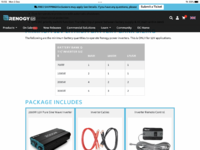Looking to add an inverter to my van. A 1500w one would be sufficient for my needs but am looking for recommendations. There are some cheap ones on ebay, but not sure i would trust them. For my budget I could get a 1500w one from Sunshine https://www.sunshinesolar.co.uk/Ite...tcNlxPaULIH9jWEP9NW7Cfq496G1KG-4aAmp8EALw_wcB
or a 2000w one from Renology https://uk.renogy.com/2000w-12v-pur...A4yVMYfPXZdh-qftnXhUObnG8mQKCC7QaAg9uEALw_wcB.
Are there any other recommendations?
Thanks
Howard
or a 2000w one from Renology https://uk.renogy.com/2000w-12v-pur...A4yVMYfPXZdh-qftnXhUObnG8mQKCC7QaAg9uEALw_wcB.
Are there any other recommendations?
Thanks
Howard



 but worthwhile considering all the possibilities
but worthwhile considering all the possibilities 